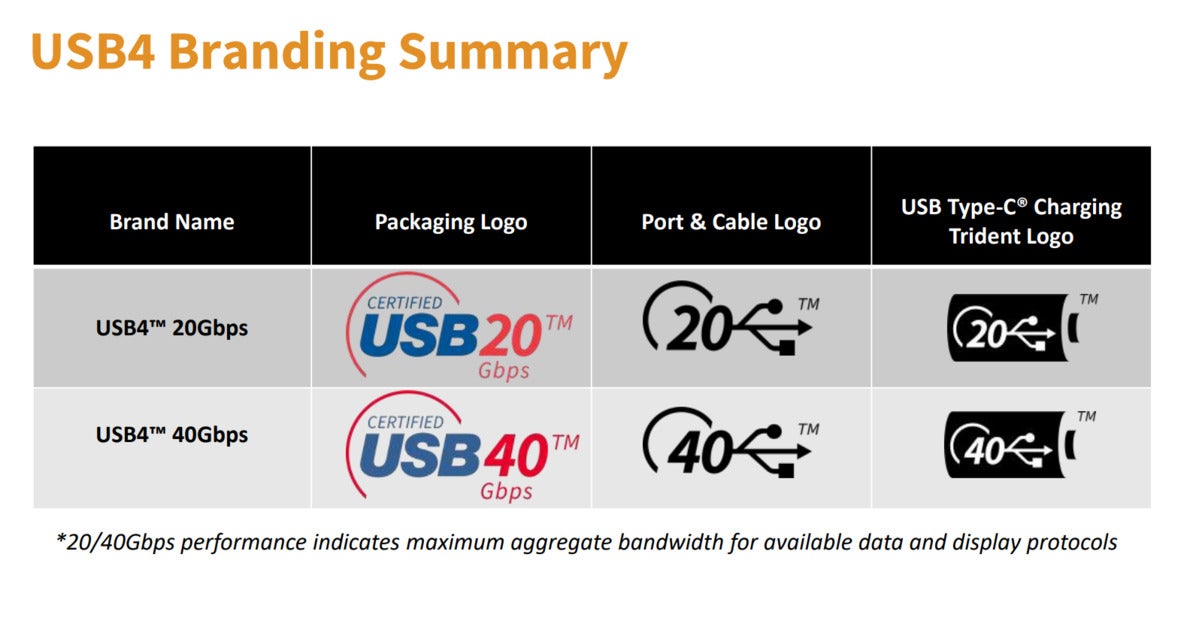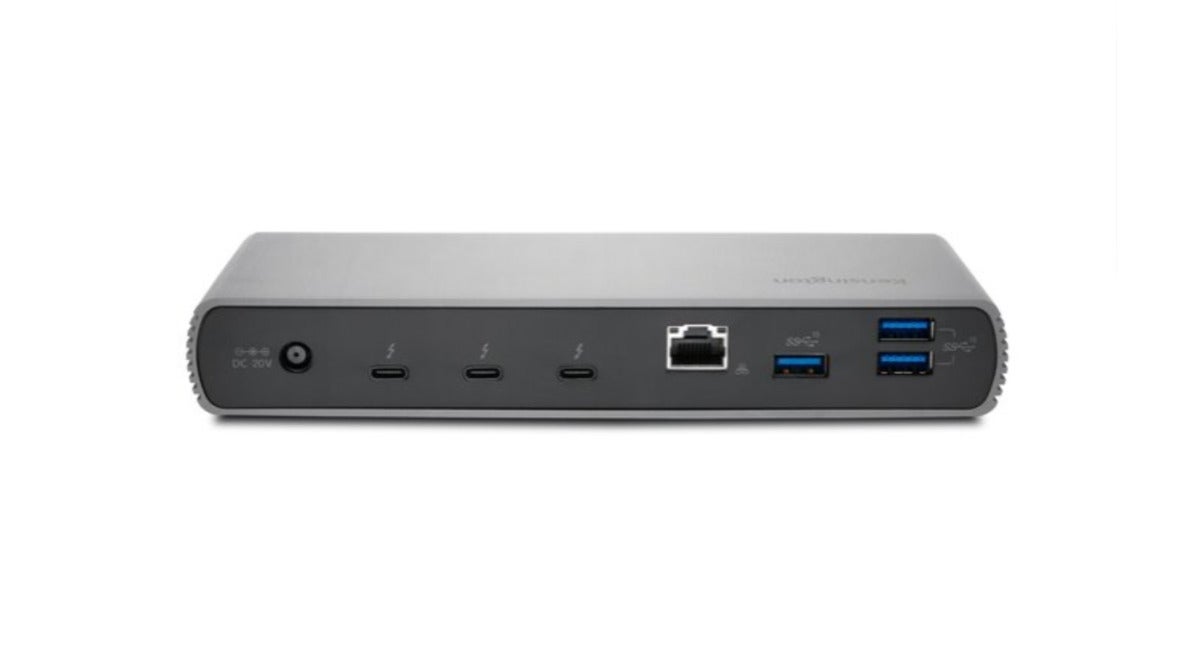The first USB4 products have begun to ship, almost a year after the specification was released. The initial products will include external storage devices, USB docks, and more, executives at the USB Implementers Forum (USB-IF) told PCWorld.
Although the USB-IF has taken some steps to reduce the confusion around USB4, it’s still going to be a little tricky to distinguish it from Thunderbolt 4—though it may not matter. Here’s what you need to know.
USB4: What you need to know
USB4 represents the closest merge to date of two I/O technologies, USB and Thunderbolt. USB has been around since 1995, providing a port for peripherals as small as a thumb drive or a mouse, or as big as a consumer printer. With USB4, however, the venerable rectangular USB-A port is finally giving way entirely to the ovular USB-C port.
Thunderbolt is a technology designed by Intel with help from Apple, with the intent of supporting a new generation of faster external storage, more sophisticated monitor technology, and more. It’s younger than USB—Intel celebrated Thunderbolt’s 10th anniversary on February 24—and is still found mostly on Macs, plus some higher-end displays, storage, and Windows PCs. The Thunderbolt 4 standard was ratified at the end of August, 2019, and has slowly worked its way from a paper specification to finished products.
Both Thunderbolt and USB4 share the same USB-C physical connector. They also overlap in terms of throughput: USB4 can operate at peak speeds of 40 gigabits per second (Gbps), the same as Thunderbolt 3 and the new Thunderbolt 4. The USB4 specification is backward-compatible, so you can connect an older USB-C device to a USB4 port. Any older device will run at its native USB speed—it can’t upgrade itself on the fly to USB4 speeds.
Here’s where it gets a little confusing. The USB4 spec doesn’t require Thunderbolt support, so you may find laptops and other devices with a simple USB4 port. The Thunderbolt 4 spec mandates the use of USB4, however, including its optional features. Laptops that include Thunderbolt 4 capability will therefore support USB4 by default. “We know that Thunderbolt 4.0 is basically USB4,” according to Jeff Ravencraft, the president and chief operating officer of the USB-IF, in an interview.
Put simply, you may see “USB4” peripherals referred to as “Thunderbolt 4” devices, instead!
Thunderbolt 4 and USB4 are also built specifically into the latest Intel-based laptops, as well as Macs. Look for Windows models built around Intel’s 11th-gen “Tiger Lake” Core processors, as well as the new Apple MacBook Air and MacBook Pro 13, a USB-IF representative noted.
With USB4, the USB-IF is making great strides in cleaning up the I/O chaos of yesteryear, as expected when the USB4 specification was announced. Gone is the horrible USB 3 naming scheme. USB4 isn’t defined by the specification, but by how fast data moves. The USB4 spec provides for two different flavors of USB4, both 20Gbps and 40Gps, each of which should be properly labeled on the product packaging.
 USB Implementers Forum
USB Implementers Forum
A summary of the two different speeds at which USB4 can run at, as indicated by the USB Implementers Forum. Interestingly, “USB4” isn’t called out in the spec—just the available bandwidth.
What USB4 devices can you buy?
Ravencraft said it’s typical that a USB specification requires 12 to 18 months to implement, from a document to shipping product. The first cables began shipping at the end of 2020, he said, and the first USB4 docking stations have hit the market as well. “We anticipate seeing the ramp begin to happen this year,” he said, even with the pandemic.
Here’s a short, non-comprehensive list of the first products to ship, as suggested by a USB-IF representative. As you shop, pay close attention to the product names, which more often than not will include “Thunderbolt 4” or “USB4” as handy cues. However, it will never hurt to skim the specs to confirm their compatibility. For example, we received an early sample of the OWC Thunderbolt 4 dock. The USB4 brand label appears nowhere on the packaging. Instead, OWC includes this note in the specifications: “Compatible with USB3, USB4, and Thunderbolt 3 and later devices.”
USB4 Docks:
OWC Thunderbolt 4 Dock (OWCTB4DOCK)Remove non-product link: $249.00
Kensington Thunderbolt 4 Docking StationRemove non-product link: $319.99
 Kensington
Kensington
Kensington’s USB4 dock.
USB4 SSDs:
Maxonar Portable 1TB SSDRemove non-product link: $199.90
USB4 Storage Enclosures:
Acasis USB4 M.2 NVMe EnclosureRemove non-product link: $139.99
Orico USB4.0 M.2 SSD Case (M2V01-C4-GY)Remove non-product link: $139.99
USB4 Cables:
Elecom USB4 40Gbps Cable (0.8m)Remove non-product link: $39.48
Cable Matters USB4 40Gbps Cable (2.6 feet)Remove non-product link: $19.99
Notebook PCs may feature USB4 branding…or not
We don’t know yet whether you’ll see any overt USB4 labeling on laptop or desktop PCs that support it. Notebook manufacturers have a limited amount of space to include any logo. Ravencraft argued that it made more sense to include a USB4 logo instead of the more generic Thunderbolt logo, because 20 billion USB products have been sold to date, compared to far fewer Thunderbolt devices. “Consumers have no clue what Thunderbolt is,” Ravencraft asserted.
Still, Rahman Ismail, the chief technology officer of the USB-IF, also noted that that laptops like the Apple MacBook don’t put any logos on their laptops at all, reserving the details for their specifications. Ravencraft agreed: “A lot of these companies do not put any markings on their ports.”
If that’s the case, your next laptop may not carry a USB4 logo—but it could support USB4 anyway, as will any Intel-based laptops with Thunderbolt 4. It’s unclear whether laptops based on AMD Ryzen CPUs will do the same. Reading the PC’s specifications carefully should help you find out for sure.
